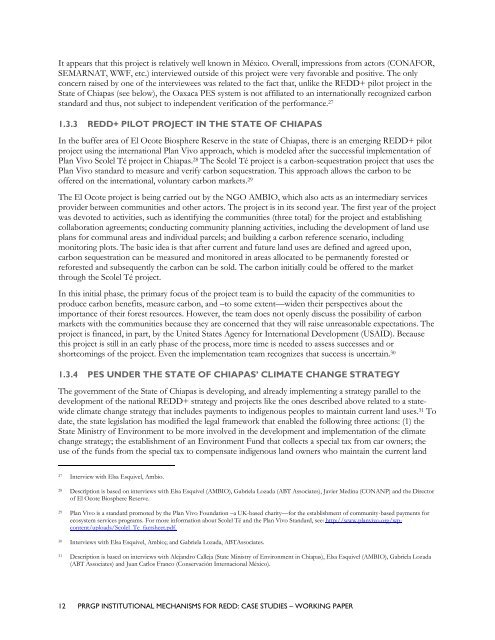Institutional Mechanisms for REDD+ - Case Studies Working Paper
Institutional Mechanisms for REDD+ - Case Studies Working Paper
Institutional Mechanisms for REDD+ - Case Studies Working Paper
Create successful ePaper yourself
Turn your PDF publications into a flip-book with our unique Google optimized e-Paper software.
It appears that this project is relatively well known in México. Overall, impressions from actors (CONAFOR,<br />
SEMARNAT, WWF, etc.) interviewed outside of this project were very favorable and positive. The only<br />
concern raised by one of the interviewees was related to the fact that, unlike the <strong>REDD+</strong> pilot project in the<br />
State of Chiapas (see below), the Oaxaca PES system is not affiliated to an internationally recognized carbon<br />
standard and thus, not subject to independent verification of the per<strong>for</strong>mance. 27<br />
1.3.3 <strong>REDD+</strong> PILOT PROJECT IN THE STATE OF CHIAPAS<br />
In the buffer area of El Ocote Biosphere Reserve in the state of Chiapas, there is an emerging <strong>REDD+</strong> pilot<br />
project using the international Plan Vivo approach, which is modeled after the successful implementation of<br />
Plan Vivo Scolel Té project in Chiapas. 28 The Scolel Té project is a carbon-sequestration project that uses the<br />
Plan Vivo standard to measure and verify carbon sequestration. This approach allows the carbon to be<br />
offered on the international, voluntary carbon markets. 29<br />
The El Ocote project is being carried out by the NGO AMBIO, which also acts as an intermediary services<br />
provider between communities and other actors. The project is in its second year. The first year of the project<br />
was devoted to activities, such as identifying the communities (three total) <strong>for</strong> the project and establishing<br />
collaboration agreements; conducting community planning activities, including the development of land use<br />
plans <strong>for</strong> communal areas and individual parcels; and building a carbon reference scenario, including<br />
monitoring plots. The basic idea is that after current and future land uses are defined and agreed upon,<br />
carbon sequestration can be measured and monitored in areas allocated to be permanently <strong>for</strong>ested or<br />
re<strong>for</strong>ested and subsequently the carbon can be sold. The carbon initially could be offered to the market<br />
through the Scolel Té project.<br />
In this initial phase, the primary focus of the project team is to build the capacity of the communities to<br />
produce carbon benefits, measure carbon, and –to some extent—widen their perspectives about the<br />
importance of their <strong>for</strong>est resources. However, the team does not openly discuss the possibility of carbon<br />
markets with the communities because they are concerned that they will raise unreasonable expectations. The<br />
project is financed, in part, by the United States Agency <strong>for</strong> International Development (USAID). Because<br />
this project is still in an early phase of the process, more time is needed to assess successes and or<br />
shortcomings of the project. Even the implementation team recognizes that success is uncertain. 30<br />
1.3.4 PES UNDER THE STATE OF CHIAPAS’ CLIMATE CHANGE STRATEGY<br />
The government of the State of Chiapas is developing, and already implementing a strategy parallel to the<br />
development of the national <strong>REDD+</strong> strategy and projects like the ones described above related to a statewide<br />
climate change strategy that includes payments to indigenous peoples to maintain current land uses. 31 To<br />
date, the state legislation has modified the legal framework that enabled the following three actions: (1) the<br />
State Ministry of Environment to be more involved in the development and implementation of the climate<br />
change strategy; the establishment of an Environment Fund that collects a special tax from car owners; the<br />
use of the funds from the special tax to compensate indigenous land owners who maintain the current land<br />
27 Interview with Elsa Esquivel, Ambio.<br />
28 Description is based on interviews with Elsa Esquivel (AMBIO), Gabriela Lozada (ABT Associates), Javier Medina (CONANP) and the Director<br />
of El Ocote Biosphere Reserve.<br />
29 Plan Vivo is a standard promoted by the Plan Vivo Foundation –a UK-based charity—<strong>for</strong> the establishment of community-based payments <strong>for</strong><br />
ecosystem services programs. For more in<strong>for</strong>mation about Scolel Té and the Plan Vivo Standard, see: http://www.planvivo.org/wpcontent/uploads/Scolel_Te_factsheet.pdf.<br />
30 Interviews with Elsa Esquivel, Ambio;; and Gabriela Lozada, ABTAssociates.<br />
31 Description is based on interviews with Alejandro Calleja (State Ministry of Environment in Chiapas), Elsa Esquivel (AMBIO), Gabriela Lozada<br />
(ABT Associates) and Juan Carlos Franco (Conservación Internacional México).<br />
12 PRRGP INSTITUTIONAL MECHANISMS FOR REDD: CASE STUDIES – WORKING PAPER

















